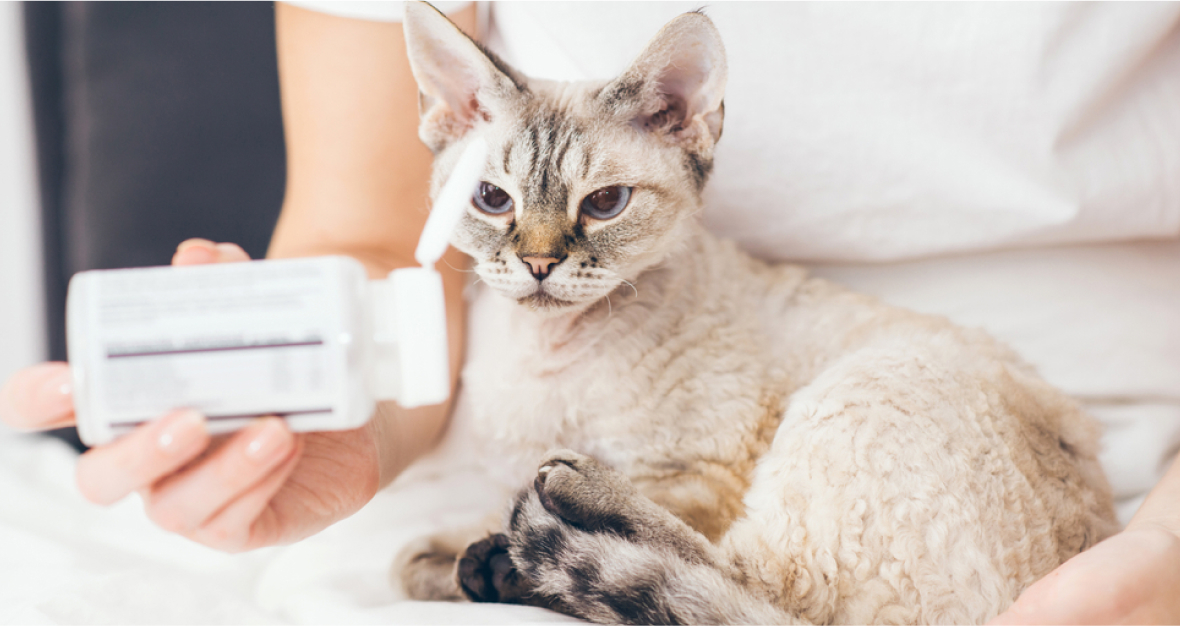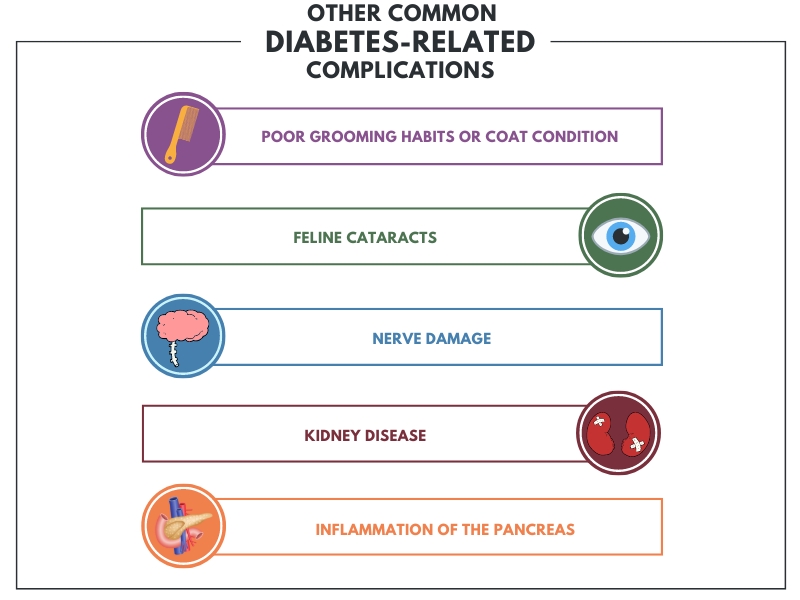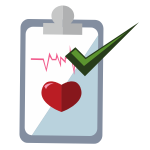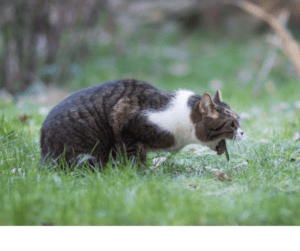Home » Pet Health » Pet Diabetes » Cat Treatment and Prevention
Cat Treatment and Prevention

When treating diabetes in cats, the primary goals are controlling blood glucose levels and preventing diabetes-related complications, such as frequent infections, weakening of hind legs, and ketoacidosis (high levels of blood acids or ketones in the body). These treatments can be through insulin therapy, dietary modifications, and oral anti-diabetic medications for less severe cases.
If you have a cat that shows clear signs of diabetes, your veterinarian will help you create an appropriate meal plan for the disease. Moreover, they will teach you how to administer the necessary medications.

Dietary Restrictions
Carbohydrates have become known as one of the primary sources of glucose, so letting your cat eat high-carb foods can increase the amount of sugar in the blood. With that, veterinarians will recommend putting diabetic cats on a high protein diet with low carbohydrates. In that way, blood sugar levels will become steady and close to average as much as possible.
To prevent diabetes, veterinarians will also recommend not letting diabetic cats consume more than 5 to 10 percent of carbohydrates from their daily meals. Aside from that, their daily dose of protein must come from animal meat. For diabetic cats, cat foods with 50% of calories from protein can be the best option.
If your cat is overweight, they need to reduce the excess weight by doing routine exercises. However, it is also not rare for cats with diabetes to lose a significant amount of weight. If that case happens to your cat, your veterinarian will most likely recommend feeding it multiple times a day to prevent unhealthy weight loss.
Insulin Therapy
Aside from the dietary changes, diabetic cats will also need to receive shots of insulin regularly. Cat owners usually administer these injections at home after receiving detailed instructions from a veterinarian.
However, since some insulins may come in different preparations and doses, it may take you a few trials before coming up with the correct and suitable variant for your cat. In most cases, cat owners will need to inject the insulin under the cat’s skin twice a day, every 12 hours.

Anti-Diabetes Medication
In some cases, some cats may also develop non-insulin-dependent diabetes, a type of diabetes that still allows a cat’s body to produce small amounts of insulin.
In these cases, veterinarians may put these cats on an anti-diabetes medication called glipizide instead of undergoing insulin therapy. This medication is effective in maintaining normal glucose levels and preventing health concerns connected with Feline Diabetes.
Management
Once a cat starts showing signs of diabetes in cats, it will need to undergo a partial or complete lifestyle change. It may be a transition to a healthier brand of cat food or longer playtime sessions to ensure that the treatment routines will work. However, it still depends on the most probable cause of the cat’s condition.
In addition to that, a cat owner must also monitor the cat’s glucose levels alongside regular veterinarian visits.
Controlled Diet

When looking for cat food that may help control your cat’s diet, you can get prescription cat food through your veterinarian. Nonetheless, regular canned cat foods are also great alternatives. Since most of them have low carbohydrates and high animal-derived protein, they can provide diabetic cats with the right amount of needed nutrition without excess carbs.
However, if your cat has become used to a kibble-only diet, the transition in its meal routines may take you some time. You may also ask your veterinarian for low-carbohydrate dry food options that you can mix with the canned cat food until your cat gets used to their new diet.
Regular Exercise

If your diabetic cat is overweight, it will be best to ensure that it gets at least 5 to 10 minutes of exercise every day. However, ensure to consult your veterinarian first before letting your cat engage in any physical activity. Your vet will help you create an exercise program that is suitable and useful for your cat.
Consulting your vet about an appropriate exercise plan is essential because you need to consider various factors, such as your cat’s size and glucose levels. Through it, your veterinarian may add or remove specific exercises and increase the routine duration as your cat loses weight.
Blood Glucose Monitoring

When controlling and managing feline diabetes, it is crucial to monitor your cat’s blood glucose levels. Even though you can do it at home using a portable glucometer or blood sugar test kit, you still need to communicate with your veterinarian.
Ensure to take down notes when checking your cat’s sugar level so that you can know if there are changes or not.
Contact your cat’s veterinarian immediately if you notice any variations or abnormalities, whether in your cat’s glucose levels or behavior (vomiting, loss of appetite, weakness, etc.). Frequently, when these things happen, there is a failure to control the cat’s condition appropriately. With that, you will need to change something in your cat’s treatment regimen or insulin dosage.
Regular Veterinary Checkups

Attending regular veterinary checkups for your cat is essential to ensure that the treatment regimen for diabetes is working and spot developing complications early. In that way, it will become easier for your veterinarian to keep track of your cat’s progress.
Moreover, you will also be able to make necessary changes to avoid diabetes-related complications and emergencies, such as hyperglycemia (high blood sugar) and insulin-induced hypoglycemia (low blood sugar).
Prevention
Preventing diabetes in cats can be as easy as letting your cat attend vet check ups regularly and live a healthy lifestyle. These things are essential, for they can do wonders for your cat’s health. Additionally, they also keep your cats from developing other medical conditions that may occur.
Healthy Diet
Meat is a crucial part of a cat’s diet since they are obligate carnivores. Even though plant-based cat foods can also bring benefits, most vitamins and nutrients cats need to stay healthy and strong can only be present in animal sources.
These nutrients and vitamins may include vitamin b12, which improves the nervous system, immune, and cognitive function; taurine, an amino acid (a building block for protein) that keeps the eyes and heart in a healthy state; and vitamin A, which promotes healthy skin and coat.

It will also be best to remember that since cats are naturally meat-eaters, they cannot correctly convert and digest plant-derived nutrients, like dogs and humans. Considering this reason, cats will need to consume the above mentioned nutrients from direct sources, such as animal meat.
Ensuring that you provide your cat with enough nutrients from appropriate food sources can significantly reduce their chances of developing health complications, like Feline Diabetes.
Adequate Physical Activity
Aside from having a healthy diet, your cat must also get enough exercise every day, whether in the form of indoor playtime sessions or daily outdoor strolls. Having an exercise routine will help them avoid gaining unnecessary weight, quickly leading to several health concerns, including Feline Diabetes.
When choosing toys for your cat, go for those that will entice them to move around to burn off excess fat more effectively.
Annual Veterinary Visits
When talking about keeping our pets healthy, we must never forget about attending vet checkups. Veterinarians suggest that pet owners bring their pets to veterinary clinics to undergo complete physical examinations at least once or twice a year.
Through these exams and sessions, your veterinarian will be able to tell if your cat is developing Feline Diabetes and provide treatment right after the diagnosis. In this case, it will prevent the condition from worsening, and it will also increase your cat’s chances of making a complete and complication-free recovery.

Frequently Asked Questions
Diabetic cats must eat meals with high proteins and low carbohydrates to best control their blood glucose levels. Since most canned cat foods usually have high proteins and low carbs, most veterinarians highly suggest giving cats canned foods. However, you still need to check their contents because some dry cat foods may have starch, which has a high amount of carbohydrates.
The frequency and amount of food you must feed your diabetic cat may vary depending on your cat’s weight and the type of diabetes it has. However, veterinarians advise most cat owners to feed their cats twice a day and administer insulin shots immediately after each meal.
Usually, cat owners must perform blood glucose monitoring for their well-regulated diabetic cats every one to three months. Nevertheless, if you have seen any changes in your cat’s energy levels, appetite, or behavior, you must immediately check its blood glucose level.
If these changes occur after a meal, make sure that you wait at least five to six hours to test since food can cause temporary blood sugar spikes.
Feeding your diabetic cat with the same amount of food every day is essential because it helps prevent blood sugar spikes. Moreover, it also makes monitoring blood sugar levels and behavioral or appetite changes more accurate and simplified.
Yes. Some cats may experience remission by maintaining an average glucose level for more than four weeks, even without oral glucose regulating medications and insulin shots. However, estimation says that 17% to 67% of cats may also go into non-diabetic remission after taking insulin shots.
The use of insulin therapy as soon as possible after diagnosis and careful adherence to a low-carbohydrate diet is critical to achieving remission. Remission is more likely with frequent monitoring and appropriate insulin dosage modifications.
Blogs

How To Identify Normal Cat Poop From Worrisome Ones?
Your cat’s poop can tell you many things about its health. Its color, shape, consistency, size, content, and odor can

Hairballs in Cats: What Are They & What Are The Signs?
Hairballs are common in cats. This condition, known as trichobezoar, occurs when hair becomes stuck in the cat’s throat, digestive

Colitis in Cats: What You Should Know
Colitis is one of the many gastrointestinal disorders that affect cats. It is a condition in which the intestine becomes

